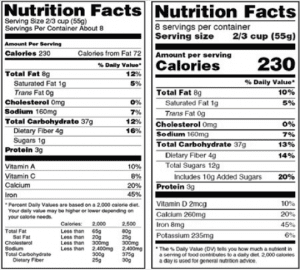
FDA Nutrition Label Changes Impact Food Packaging Design
On May 20th, 2016 the U.S Food and Drug Administration (FDA) issued new rules for nutrition labels and packaged foods. So how does this affect private label packaging or food packaging design in general? It’s been 20 years since any major revision has been made and to my assessment, a much needed one.
The purpose of this blog is to discuss the design only and not the new laws that revolve around the change including new line items and removal of some items.
What visual has changed?
- Serving Size has increased in font size and has become a bold font.
- The largest change has been the revision to calories. The font has increased at least three times and the number following it is the largest number on the label.
- The addition of “Added Sugars” has moved the “Total Fat line through Protein” over 3/4 of the label. This shift really cleans up the label.
- Removing Vitamin A and C was replaced with Vitamin D and Potassium so nothing in quantity truly changed.
- Moving The % Daily Value (DV) information to the bottom with a solid 3 point line helps ground the information.
Overall, this new label clearly brings quicker clarity to the consumer of the benefits of each product. The average male needs 2,500 calories while the average female needs 2,000. Finding Calories faster will either bring the experience with your brand into the shopping cart or left on the shelve.
Today’s nutritional facts label is now a “billboard” for how healthy your food product is perceived to be.
Need to strengthen your brand? Download our free guide to the StoryBranding process.
Today, more and more restaurant chains are displaying the calorie count, but how does that affect buying behavior? It’s been a debate of the nationwide experiment into human behavior.
As more and more chains and restaurants are showing you the calorie intake, deep down it is not affecting sales. The changes are so subtle.
Brian Elbel, associate professor of population health at New York University’s School of Medicine, spent weeks outside fast food restaurants talking to customers and saving their receipts, to investigate the impact of these changes. He found “It doesn’t appear to be changing what people order for fast food at a population level.”
So with all this said, will America in general read any of the much larger calorie count to change what they buy and how they buy it? Its seems doubtful, but time will tell.
Want to learn more about how updating your package design can drive sales?

Mark Beebe oversees all current clients. His secondary focus is leading the creative with original thinkers who provide innovative processes and insightful answers for clients’ marketing needs. His 30+ years has garnered the team to over 50+ national and international awards. As a partner, Mark, looks for unusual solutions to bring smart results and metrics to your bottom line.






